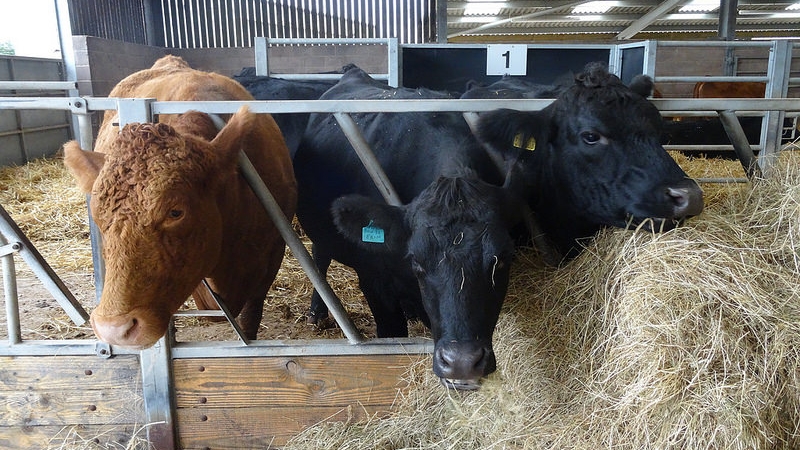Editors blog: Homegrown feed, soil erosion and pants!
 In November Agricology celebrated its second birthday! Over the last two years the Agricology community of farmers, advisors and researchers has really grown, and over 1.5 million people have engaged on the website, social media and in the field events; sharing knowledge and experiences of sustainable farming. Thank you all for being part of that and we look forward to the community growing in the coming years as more farmers and growers move towards more resilient, lower input farming systems.
In November Agricology celebrated its second birthday! Over the last two years the Agricology community of farmers, advisors and researchers has really grown, and over 1.5 million people have engaged on the website, social media and in the field events; sharing knowledge and experiences of sustainable farming. Thank you all for being part of that and we look forward to the community growing in the coming years as more farmers and growers move towards more resilient, lower input farming systems.
In November we had a deeper look at how you can prevent soil erosion and poor drainage on your farm. Thanks for sharing your thoughts and ideas about how to do this. One Twitter user posted a fascinating video produced as part of the Soil Life in Action project showing bioturbation (the mixing of plant residues into soils and sediments by biotic activity if you didnt know!) in action. It provides a great visual demonstration of the importance of soil biota in enhancing soil fertility and structure, and increasing air and water flow through the soil.
 Another Twitter user posted a news article about a farmer burying cotton underpants in his fields to get an indication of the soil fertility (see right), the theory being that the more the material disintegrates, the healthier and more robust the soil is!
Another Twitter user posted a news article about a farmer burying cotton underpants in his fields to get an indication of the soil fertility (see right), the theory being that the more the material disintegrates, the healthier and more robust the soil is!
As Felicity Crotty from the GWCT says in her blog, five main factors impact the health of the soil and can greatly influence its capability and resilience to function; soil structure, soil chemistry, organic matter content, soil biology, and water infiltration, retention and movement through the soil profile. All can be addressed through various practices, some of which we featured in content during November and have highlighted in this month’s newsletter.
We featured two LEAF videos; one describing measures put in place to reduce the impacts of soil erosion on a Somerset farmer’s poultry and arable farm; including implementing minimum tillage, cover crops, incorporating poultry litter to help build soil organic matter, and using sediment filter fences to help slow water down, reduce topsoil erosion and prevent sediment from running off.

Minimum tillage…
The other focuses on improving soil structure and function on a farm in the Lincolnshire Wolds. It emphasises the beneficial impacts of improving soil organic matter – on reducing erosion and improving drainage and water retention, and the importance of waiting for soil to dry out before working it, avoiding compaction. It also demonstrates the knock-on benefits from improving the farm drainage system in relation to having more choice as to when you can carry out drilling and improved black-grass control.
Trees have featured heavily in our promoted content, one of which was a Woodland Trust case study of a Nottingham arable farmer who needed to reduce the soil erosion on his farm exposed to strong winds and intensive rainfall that can wash away valuable top soil. It explains how he has used trees to help him do this, and how you could work with the Woodland Trust to do something similar. Trees can help save your soil!
The other area we focused on during November was that of livestock feed self-sufficiency. Tim Downes, our featured farmer, encourages his dairy cattle to browse hedgerows and trees on the farm as part of a ‘high quality grazing for herd health strategy’, recognising the potential health-giving nutritional and medicinal properties from it.
(1).jpg)
Dairy cattle grazing on Tim farm – as featured in his farmer profile
To maximise the milk from grass and pasture productivity, he also grows diverse swards and practices rotational grazing, something that Ian Wilkinson of Cotswold Seeds also advocates in relation to herbal leys in a featured article that describes the diverse benefits of growing them as forage crops for ruminants. A diverse mix of species with varying growth patterns and habits can provide wholesome forage nearly all year round.
Another featured article focusing particularly on feeding dairy cows in winter, looks at the innovative system organic dairy farmer Henry Gent put in place to overcome the issue of needing a steady milk supply without a consistent guaranteed grass supply, and not wanting a high-input silage-based system.  AHDB Dairy tweeted urging farmers to “exploit the true value of silage to cut concentrate costs.” (See Twitter post right). If you are facing silage clamps that may look less full this winter, they are advising you to do some simple calculations before reaching for the concentrates.
AHDB Dairy tweeted urging farmers to “exploit the true value of silage to cut concentrate costs.” (See Twitter post right). If you are facing silage clamps that may look less full this winter, they are advising you to do some simple calculations before reaching for the concentrates.
 Richard Smith (pictured right) gives some insights into raising turkeys and the feeding system at Daylesford Organic Farm in his vlog. Turkeys are fed home grown oats and encouraged to range in a system based on promoting health and welfare to maximise taste.
Richard Smith (pictured right) gives some insights into raising turkeys and the feeding system at Daylesford Organic Farm in his vlog. Turkeys are fed home grown oats and encouraged to range in a system based on promoting health and welfare to maximise taste.
One of our featured resources, a factsheet created by Farming Connect, considers options for growing your own poultry feed; looking at dehulling protein crops, home-grown sunflowers and naked oats. It examines what they can provide in terms of both nutritional and monetary value and sets out some of the challenges and considerations for producers in relation to marketing and production.
We are also getting excited about the Agricology Field Day at Daylesford on 3rd January. Mixing it Up; Leys, Livestock and Arable is a fringe to the Oxford Conferences – pop in on your way or hop on our special bus from Oxford. We will be exploring the potential of reintegrating livestock and cropping systems to enhance soil, manage problem weeds and build more resilient lower input systems. We have a fantastic group of innovative farmers and researchers who will share their own innovations and ideas to inspire both arable and livestock farmers to mix it up! We will discuss practical questions around establishment, species and breed selection, benefits for soil health, weed control, yields, and overcoming some of the challenges. Have you got your ticket yet? More information here.
December’s content themes are farm ecosystem ‘health’ and holistic whole farm management. You can contact us on enquiries@agricology.co.uk or use Facebook, Instagram, Youtube, Twitter (@gricology) to suggest content, ask questions and join in the conversation.
Wishing you all a happy and peaceful Christmas break…

Frosted hawthorn. Photo credit: Rachel Lewis
Janie Caldbeck is the Content Editor for Agricology

